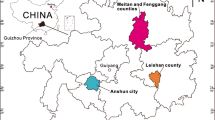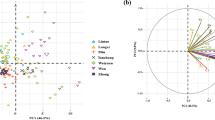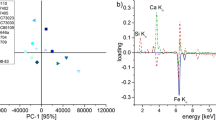Abstract
This study investigated the feasibility of using the mineral element contents and 87Sr/86Sr ratios of blueberries to trace their origins. The contents of 28 mineral elements, including K, Al, and Mg, were determined in 104 blueberry samples from three blueberry-producing areas in Guizhou Province, China. Also determined were both the 87Sr/86Sr ratios in 48 blueberry samples as well as the type of soil in which the blueberries were grown. Cluster analysis of 87Sr/86Sr ratios, stepwise discriminant analysis of mineral element contents, and combined discriminant analyses of 87Sr/86Sr ratios and mineral element contents were done. The results show that ten elements (Ca, Cr, Cs, Mg, Mn, P, Rb, Sb, Th, and Y) were selected by linear discriminant analysis, which could be used to establish the provenance traceability model of blueberries in Guizhou. The original accuracy of linear discriminant analysis was 89.4%, and the accuracy of cross-validation was 83.6%. When 87Sr/86Sr ratios were used for tracing, the accuracies of both the original discrimination and the cross-validation were 81.3% as determined by linear discriminant analysis, and the accuracy rate of origin discrimination was 81.25% by cluster analysis. The results of combined discrimination were the best: the accuracy of the original discrimination was 95.8%, and the accuracy of cross-validation was 93.8%. Mineral element contents and 87Sr/86Sr ratios can be used to trace the origins of blueberries, and combining them can significantly improve the discrimination accuracy. Fisher linear discriminant analysis had the greatest accuracy followed by cluster analysis, while principal component analysis was relatively poor in the research of Guizhou blueberry origin traceability.






Similar content being viewed by others
Data availability
The data used to support the findings of this study are available from the corresponding author upon request.
References
Pang RL, Wang SY, Wang RP, Dang Q, Guo LL, Xie HZ, Fang JB (2018) The application of isotope technology in the tracing of fruit and products. J Fruit Trees 06:747–759. https://doi.org/10.13925/j.cnki.gsxb.20170339
Franke BM, Gérard G, Hadorn R (2005) Geographic origin of meat-elements of an analytical approach to its authentication[J]. Eur Food Res Technol 221(3-4):493–503. https://doi.org/10.1007/s00217-005-1158-8
Ding CY (2016) Food traceability information and its supervision. Soc Under Rule Law (02):57-67. https://doi.org/10.19350/j.cnki.fzsh.2016.02.008
Li YD, Pei JB, Chen L, Sun HY (2021) Annual report of blueberry industry in China 2020 [J / OL]. J Jilin Agric Univ 1–8. https://doi.org/10.13327/j.jjlau.2021.1071.
< DB52/7 1192-2017>-Notice of AQSIQ on approving the implementation of geographical indication product protection for 37 products including Majiang Blueberry [R], General Administration of quality supervision, inspection and Quarantine of the people's Republic of China, 2016 (63)
Giuseppe M, Carla G, Massimo E and Maffei (2019) Chemical partitioning and DNA fingerprinting of some pistachio (Pistacia vera L.) varieties of different geographical origin. Phytochemistry 160. https://doi.org/10.1016/j.phytochem.2019.01.010
Zhang J, Tian ZQ, Ma YQ, Shao FL, Huang JL, Wu H, Tian L, Lozano J (2019) Origin identification of the sauce-flavor Chinese Baijiu by organic acids, trace elements, and the stable carbon isotope ratio. J Food Qual 2019:1–7. https://doi.org/10.1155/2019/7525201
Fu HY, Fan Y, Zhang X, Lan HY, Yang TM, Shao M, Li SH (2015) Rapid discrimination for traditional complex herbal medicines from different parts, collection time, and origins using high-performance liquid chromatography and near-infrared spectral fingerprints with aid of pattern recognition methods. J Anal Methods Chem 2015:727589. https://doi.org/10.1155/2015/727589
Lai HQ, Xi JL, He WZ, Wang CH and Mao XF (2020) Origin traceability of soybean in northern China based on mineral element fingerprint analysis. Chin Food Nutr (07):17-21 https://doi.org/10.19870/j.cnki.11-3716/ts.2020.07.005.
Werner SJ, Hobson KA, Van WSL, Fischer JW, Roberto A (2016) Multi-isotopic (δ2H, δ13C, δ15N) tracing of molt origin for red-winged blackbirds associated with agro-ecosystems. PLoS One 11:e0165996. https://doi.org/10.1371/journal.pone.0165996
Hidalgo MJ, Fechner DC, Marchevsky EJ, Pellerano RG (2016) Determining the geographical origin of Sechium edule fruits by multielement analysis and advanced chemometric techniques. Food Chem 210:228–234. https://doi.org/10.1016/j.foodchem.2016.04.120
Yan J, Liu J, Xiong Y, Qin W, Tang C (2015) Identification of the geographical origins of pomelos using multielement fingerprinting. J Food Sci 80:C228–C233. https://doi.org/10.1111/1750-3841.12746
Li XP, Li JQ, Li T, Hg L, Wang YZ (2018) The identification method of edible Boletus based on multi-source heterogeneous spectral information fusion. Spectrosc Spectr Anal 38:3897–3904. https://doi.org/10.3964/j.issn.1000-0593(2018)12-3897-08
Zhang J, Yang RD, Li YC, Wen XF, Peng YS, and Ni XR (2020) Use of mineral multi-elemental analysis to authenticate geographical origin of different cultivars of tea in Guizhou, China. J Sci Food Agric. https://doi.org/10.1002/jsfa.10335
Li XH, Li XZ, Bai YS, Li CR, Zhang Y, Wang HF, Yang SQ, Guan ZH (2018) Study on origin traceability of yam based on mineral element fingerprint. Henan Sci 36(05):712–716
Du MJ, Fang Y, Shen F, Mao B, Zou YY, Li P, Pei F, Hu QH (2018) Multiangle discrimination of geographical origin of rice based on analysis of mineral elements and characteristic volatile components. Int J Food Sci Technol 53:2088–2096. https://doi.org/10.1111/ijfs.13795
Lu B, Zhang D (2017) Origin traceability of Heilongjiang soybean using fingerprint of mineral elements. Nong ye Gong cheng Xue bao/Trans Chin Soc Agric Eng 33:216–221. https://doi.org/10.11975/j.issn.1002-6819.2017.21.026
Zhang JY, Nie JY, Kuang LX, Shen YM and Asim S (2019) Geographical origin of Chinese apples based on multiple element analysis. J Sci Food Agric. https://doi.org/10.1002/jsfa.9890
Potortì AG, Bella DG, Mottese AF, Bua GD, Fede MR, Sabatino G, Salvo A, Somma R, Dugo G and Turco LV (2018) Traceability of protected geographical indication (pgi) interdonato lemon pulps by chemometric analysis of the mineral composition. J Food Compos Anal S0889157518300632. https://doi.org/10.1016/j.jfca.2018.03.001
Chen H, Fan CL, Chang QY, Pang GF, Hu XY (2015) Application of ICP-MS method in the determination of mineral elements in vitex honey for the classification of their geographical origins with chemometric approach. Food Biosci 35:212–216. https://doi.org/10.3964/j.issn.1000-0593(2015)01-0212-05
Diana CF, Hidalgo MJ, Ruiz Díaz JD, Gil RA, Pellerano RG (2020)Geographical origin authentication of honey produced in Argentina - ScienceDirect. Food Biosci 33. https://doi.org/10.1016/j.fbio.2019.100483
Kang L, Zhu JR, Zhao DY, Liu HJ, Wang C (2017) Feasibility study on the origin of Ruoqiang grey jujube. Xinjiang Agric Sci 54:1066–1075. https://doi.org/10.6048/j.issn.1001-4330.2017.06.013
Liu H, Wei Y, Lu H, Wei S and Guo BL (2017) The determination and application of 87Sr/86Sr ratio in verifying geographical origin of wheat. J Mass Spectrom 52. https://doi.org/10.1002/jms.3930
Wang J, Shi YZ, Zhang QF, Ni K, Yi XY, Ma LF, Ruan JY (2017) Origin of Longjing tea based on mineral element fingerprint. J Nuclear Agric 31:547–558. https://doi.org/10.11869/j.issn.100-8551.2017.03.0547
Wu ML, Yang XM (2017) Application of strontium isotope tracing method in ancient textile research. Silk 54:51–54. https://doi.org/10.3969/j.issn.1001-7003.2017.05.009
Baroni, María V, Podio NS, Badini RG, Inga M, Ostera HA, Cagnoni M, Gautier EA, García PP, Hoogewerff J, Wunderlin DA (2015) Linking soil, water, and honey composition to assess the geographical origin of Argentinean honey by multielemental and isotopic analyses. J Agric Food Chem 63:4638. https://doi.org/10.1021/jf5060112
Peng DQ, Yan C, Wu YG, Zhang JF, Wang CH (2019) Simultaneous determination of 24 mineral nutrient elements in different parts of Camellia oleifera in Hainan by ICP-MS and their enrichment. Jiangsu Agric Sci 47(08):202–204. https://doi.org/10.15889/j.issn.1002-1302.2019.08.047
Fagbohun OF, Babalola OO, Agboola FK, Joseph JS, Malindisa SM, Titus AM (2020) Evaluation of phytochemicals, antioxidants, trace elements in Kigelia africana fruit extracts and chemical profiling analysis using UHPLC-qTOF-MS2 spectrometry. Biol Trace Elem Res 195:2. https://doi.org/10.1007/s12011-019-01869-2
Zhao CY (2019, 2019) Study on tracing ancient human migration by strontium isotope analysis technique. Northern Cultural Relics 43:–49. https://doi.org/10.16422/j.cnki.1001-0483.2019.03.007
Li B, Peng J, Xia QS, Yang SJ, Hao YQ (2019) Dolomitization model of Cambrian xiaqiulitage group in Tabei area. J Jilin Univ (Earth Sci Ed) 49:310–322. https://doi.org/10.13278/j.cnki.jjuese.20170219
Funding
This project was financially supported by the National Natural Science Foundation of China (41563011 and 41463009), Growth Project of Young Scientific and Technological Talents of Guizhou Provincial Department of Education, KY [2016] 177, Project of Humanities and Social Sciences Research Base of Guizhou Provincial Department of Education (No. 2018jd074), and Key Project of Joint Research Fund of Ministry of Commerce: “Research on targeted poverty alleviation and poverty alleviation in the upper reaches of the two rivers” (No. 2016swbzd19).
Author information
Authors and Affiliations
Corresponding author
Additional information
Publisher’s Note
Springer Nature remains neutral with regard to jurisdictional claims in published maps and institutional affiliations.
Rights and permissions
About this article
Cite this article
Li, Q., Li, C., Xiao, S. et al. Tracing the Origins of Blueberries by Their Mineral Element Contents and 87Sr/86Sr Ratios. Biol Trace Elem Res 200, 920–930 (2022). https://doi.org/10.1007/s12011-021-02701-6
Received:
Accepted:
Published:
Issue Date:
DOI: https://doi.org/10.1007/s12011-021-02701-6




